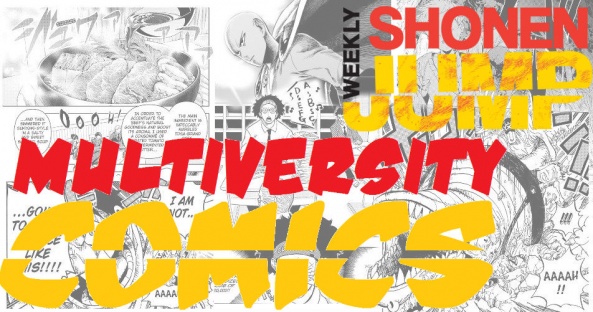
Welcome to This Week in Shonen Jump, our weekly check in on Viz’s various Shonen Jump series. Viz has recently changed their release format, but our format will mostly remain the same. We will still review the newest chapters of one title a week, now with even more options at our disposal. The big change for our readers is that, even without a Shonen Jump subscription, you can read these most recent chapters for free at Viz.com or using their app.
This week, Rowan checks in with “Dear Anemone.” If you have thoughts on this or any other current Shonen Jump titles, please let us know in the comments!

Dear Anemone chapter 1
Written and Illustrated by Rin Matsui
Translated by Jan Cash
Lettered by Finn K.
Reviewed by Rowan Grover
As far as first impressions go, I have to give “Dear Anemone” some props. It’s easily one of the most visually upsetting Shonen debuts I’ve read in a while. But the way it upsets is a bit of a mixed experience. Let me explain.
“Dear Anemone” on the surface is a horror comic. Rin Matsui isn’t shy about presenting this to the readers. The first few pages we get a flash-forward, drenched in shadow-heavy digital paints. The material is immediate in how it sets tone: there’s blood and gore, and a supernatural plant monster wrapped around a terrifying human. It’s a great cold open that dared me to dig into whatever the heck this manga contained.
From here we get the framing premise explained. A bunch of young adult biologists are shipped off to Galapagos Island, an actual place off the coast of Ecuador. They’re sent under the pretence of a rescue team, gone to retrieve a previous set of explorers after a volcanic incident occurred on the island ten years earlier. The real reason is a little vague, but from what I can gather in this issue, it is because the biologists have been handpicked for the genetic potential, to be evolved by the mysterious forces awoken on Galapagos Island. The concept is solid: exotic island, big monsters, government conspiracies. It’s playing the hits in a way that’s satisfying to read.
Let’s pop the characters under the microscope, however. This is one of Matsui’s weaknesses as creator of this manga. The main character, Hachiue, is a meek person wanting to actively change into someone more proactive and successful. The need to change drove them to come to the island, which is a fair enough reason for us to latch onto, but a little open-ended and nebulous for my personal taste. Then, we get a supporting character who looks enough like Hachiue that I got confused a few times. Additionally, this character has an annoying anachronistic speech pattern. The fact he drops the terms “highfallutin’” and “ding-a-ling” should tell you enough, and he sucks all the attention to him in any given sequence. At the very least, Matsui pays off how annoying he is by killing him off at the first monster reveal. But it makes the pace of the first half of the book a lot slower.
The art here is the stronger element by far. Matsui’s work feels closer to something being published in a Seinen manga than a Shonen debut. The creatures and monsters that appear on Galápagos Island are horrifying, to say the least. They are decorated with distended limbs, gilded with veiny, muscly skin, and spotted with uncanny human features that contrast the animalistic in a very confronting way. One of the monsters is a giant humanoid rooster, whose mouth is stuck open to reveal a set of pearly whites sprouting from wrinkled gums. Matsui knows how to twist the mundane enough to make it disgusting to behold.
This level of horrific detail comes at the expense of the character work, however. Matsui seems to obsess over high detail in his work. So much so that often we’ll get a shot of Hachiue with his facial features mid-proportioned, but rendered in loving, inky detail. It makes for an uneven reading experience when you receive this level of character work where the facial expressions are also repetitive over several more pages. The beautiful monster set pieces do a lot of heavy lifting in this comic, but it makes the smaller moments more of a chore to read.
At the end of it all, I do appreciate how Matsui subverted my expectations. What I thought was going to be a straightforward body horror monster comic, certainly was that. But it also levels the playing field by giving Hachiue access to a monster of his own. On this level, I’m intrigued to keep reading to see how this setup plays out. It’s just unfortunate that the character work, narratively and visually, isn’t as well thought out as the concept or monster designs.
Final Score: 7.0 – A solid debut that rides on its shocking visuals and concepts, but needs to work on its characters a little more.






